The Evolution of Virtual Reality in Gaming
Virtual reality in gaming has evolved remarkably over recent years. It’s shifted from a niche technology to a mainstream necessity, driven by constant innovation and groundbreaking advancements.
From Novelty to Necessity
Previously viewed as a luxury, VR has become integral in gaming. Early VR systems, like Nintendo’s Virtual Boy in 1995, had limited success due to technological constraints.
Yet, with improvements in hardware and software, such as the Oculus Rift and PlayStation VR, VR gained traction.
The increased demand for immersive experiences made VR essential, influencing both game development and player expectations.
Major Milestones in VR Gaming Technology
Several key developments have marked VR’s journey in gaming:
- 1990s Beginnings: The SEGA VR headset and Nintendo’s Virtual Boy introduced early VR concepts but struggled due to poor graphics and comfort issues.
- 2012 Oculus Rift Kickstarter: Oculus VR’s successful crowdfunding campaign sparked renewed interest in VR gaming, leading to the modern VR era.
- 2016 Mainstream Adoption: Oculus Rift and HTC Vive’s commercial launches brought VR to the masses, paired with high-quality graphics and user-friendly interfaces.
- Inside-Out Tracking: Microsoft’s introduction of inside-out tracking with the Windows Mixed Reality headsets in 2017 eliminated the need for external sensors, enhancing user experience.
- Standalone Headsets: The Oculus Quest’s 2019 release marked significant progress with a wireless, all-in-one VR system, making VR more accessible and convenient.
These advancements showcase VR’s transition from a futuristic concept to a fundamental element in gaming.
By consistently pushing technological boundaries, VR continues transforming how we experience games, making immersive gameplay the new standard.
How Virtual Reality Enhances Gaming Experiences
Virtual Reality (VR) gaming fosters unprecedented immersion and interaction. It’s transforming how users engage with digital worlds.
Immersive Environments and Realistic Interactions
VR creates convincing environments and life-like interactions. Players feel physically present in the game world due to advanced graphics and 3D audio.
Examples such as “Half-Life: Alyx” and “Beat Saber” demonstrate VR’s capacity to meld players into their surroundings.
Motion controllers and haptic feedback enrich experiences by mimicking real-world touch and movement.
The Role of Hardware in VR Immersion
High-performance hardware drives VR immersion. Devices like:
- Oculus Quest
- HTC Vive Pro
utilize powerful sensors and precise tracking.
These components ensure smooth gameplay and minimize latency, important for reducing motion sickness.
GPU power handles complex graphics rendering, while adaptive refresh rates enhance visual smoothness. Users experience greater realism and fluid transitions, essential for extended play sessions.
Challenges and Solutions in VR Gaming
Despite VR’s rapid ascent, the gaming industry faces significant challenges. Overcoming these is crucial for broader adoption and seamless user experiences.
Technical Limitations and Their Overcoming
Technical limitations in VR gaming hinder performance and user experience. One primary issue is latency, where delays in rendering or tracking degrade immersion.
Developers use techniques like foveated rendering, which focuses resources on the user’s direct line of sight, to mitigate latency.
Another challenge is motion sickness, often caused by mismatches between visual inputs and physical movement.
Solutions include improved frame rates, up to 120 Hz, and advanced motion algorithms to synchronize user actions with displayed content.
Companies like:
- Oculus
- HTC
constantly refine hardware and software to address these issues.
Accessibility and Cost Issues
Accessibility and cost remain barriers to widespread VR adoption. High-end VR systems, such as the HTC Vive Pro, can exceed $1,000, making them unaffordable for many.
To counter this, budget-friendly options like the Oculus Quest 2 offer a more accessible entry point at around $299, balancing performance and cost.
Furthermore, VR experiences require significant space, posing challenges for users with limited physical areas.
Developers now create games with stationary modes or seated experiences, broadening the range of environments suitable for VR gaming.
Educational initiatives and public VR installations also increase accessibility, allowing users to experience VR without hefty investments.
As technology progresses and production costs lower, VR gaming will likely become more accessible to a broader audience.
Future Trends in VR Gaming

Future trends in VR gaming focus on technological advancements and industry predictions. The landscape is rapidly changing, driven by innovation and growing adoption.
Developments to Watch in VR Technology
Developments in VR technology are opening new possibilities for gaming.
- Eye-tracking enables more immersive experiences by adjusting displays based on where players look.
- Examples include dynamic rendering in games like “Lone Echo II.” Hand-tracking eliminates the need for controllers, allowing for more natural movements.
- The Oculus Quest 2 integrates this feature, enabling intuitive interaction. Haptic feedback is evolving to provide more tactile experiences.
- Full-body haptic suits like those from TESLASUIT are enhancing immersion by delivering tactile sensations.
- Advancements in wireless technology are reducing latency.
- Technologies such as 5G are enabling faster and more reliable wireless connections, improving the overall VR experience.
- Cloud computing is being utilized to offload processing tasks, making VR systems more powerful and accessible.
- Companies like NVIDIA are working on cloud-based VR solutions that minimize hardware limitations.
- Enhanced graphics rendering is making VR worlds more realistic.
- The integration of ray tracing in VR games ensures lifelike lighting and shadows, as seen in titles like “Minecraft RTX.”
Predictions for VR in the Gaming Industry
Predictions for VR in the gaming industry suggest significant growth and innovation. Rising adoption rates indicate VR gaming will become more mainstream.
A report by Statista predicts the VR gaming market will surpass $45 billion by 2027.
Cross-platform compatibility is expected to increase. Games will allow seamless play across various VR headsets, making VR gaming more accessible.
Social VR experiences are set to expand. Virtual worlds like:
- VRChat
- Rec Room
offer social spaces for players to interact, creating new ways to engage with games.
Companies are investing in VR esports, turning competitive VR gaming into a spectator sport. VR arcades and location-based entertainment will grow as public interest increases.
Places like Sandbox VR are creating immersive experiences for multiple players in shared spaces.
Educational and training applications of VR in gaming will expand. VR simulations are being used for training in various fields, from military exercises to medical procedures.
The blending of VR with emerging technologies like AI will create smarter, more adaptive gaming environments.
AI-driven NPCs will react more naturally, providing a more engaging experience.

 Oliver Paget is a seasoned gambling advisor and prolific article writer, contributing his extensive knowledge and expertise to Gamble Guru Gate. With a background steeped in the gambling industry, Oliver has become a trusted voice for both novice and experienced gamblers seeking reliable information and strategic advice.
Oliver's journey into the gambling world began with a fascination for the statistical and psychological aspects of gaming. This curiosity led him to pursue advanced studies in statistics and psychology, equipping him with a deep understanding of game theory, risk management, and player behavior. His academic background, combined with hands-on experience in various gambling environments, allows Oliver to offer a well-rounded perspective on the industry.
Oliver Paget is a seasoned gambling advisor and prolific article writer, contributing his extensive knowledge and expertise to Gamble Guru Gate. With a background steeped in the gambling industry, Oliver has become a trusted voice for both novice and experienced gamblers seeking reliable information and strategic advice.
Oliver's journey into the gambling world began with a fascination for the statistical and psychological aspects of gaming. This curiosity led him to pursue advanced studies in statistics and psychology, equipping him with a deep understanding of game theory, risk management, and player behavior. His academic background, combined with hands-on experience in various gambling environments, allows Oliver to offer a well-rounded perspective on the industry.
